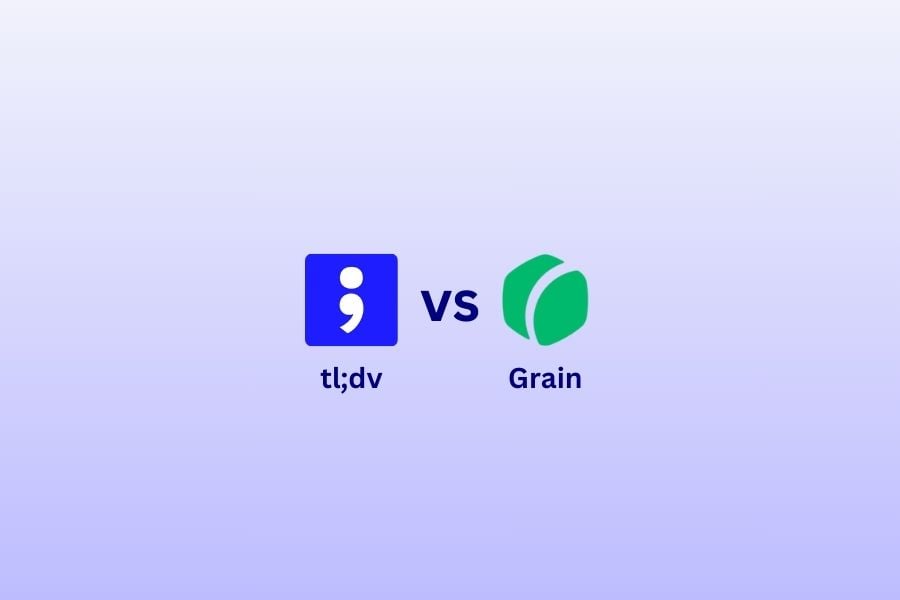It’s the moment you’ve all been waiting for: tl;dv vs Grain, the ultimate showdown. By the end of this comprehensive article, you’re gonna understand which of these two heavyweight giants is the best for your business.
To clarify, both of these tools are great for recording meetings, transcribing calls, and getting AI insights post-call. However, a general statement like that doesn’t quite cut it around here. We’ll take a deep dive into every category imaginable to compare tl;dv and Grain across each and every feature they’ve got.
If you aren’t sure which of these two tools should be your AI notetaker for your portion of the 55 million meetings held each week (in the USA alone!), then you will be come the end of this article.
So let’s get down to business.
Table of Contents
tl;dr
| tl;dv | Grain | |
|---|---|---|
| Transcription | 20 | 21 🟢 |
| Recording | 18 🟢 | 14 |
| Conversational Intelligence | 14 🟢 | 11 |
| Automation & Integrations | 10 🟢 | 4 |
| Note-taking | 10 🟢 | 6 |
| Security | 19 🟢 | 8 |
| Coaching | 8 🟢 | 0 |
| Admin | 8 🟢 | 4 |
| Organizational | 12 🟢 | 8 |
| Support | 4 🟢 | 2 |
| Revenue Intelligence | 0 | 0 |
| Other | 6 🟢 | 3 |
| Total | 128 🟢 | 81 |
Based on the results above, which we’ll dive into deeper soon, tl;dv stands out as the clear victor. It scores a whopping 128 points, compared to Grain’s respectable 81.
Most of tl;dv’s success comes from the fact it has a bunch of sales coaching features, including for objection handling, for which Grain offers no competition. With tl;dv, you can also search and generate reports across multiple meetings simultaneously (as well as record two or more meetings at the same time). It takes AI notetaking to the next level.
tl;dv also excels with its integrations, offering all 5,000+ in its Pro plan. Grain, on the other hand, has just 7 native integrations, some of which (like Salesforce) aren’t unlocked until the Business plan.
Grain does come out on top for its transcription capabilities however, offering cutting-edge real-time transcriptions, but only for Zoom calls. It also has a built-in filler word removal system that keeps transcripts free from clutter. Additionally, it has an option for custom vocabulary, empowering users to add their own jargon so that Grain’s intuitive AI can pick it out in the transcript. This is something tl;dv currently lacks but is working on implementing.
Finally, both tools are easy to get started with, but Grain’s free plan is limited to just 20 meetings and the most basic of features. tl;dv, on the other hand, offers unlimited recording and transcribing for free, as well as limited versions of their more advanced features. This makes it the ideal place to start if you want to try before you buy.
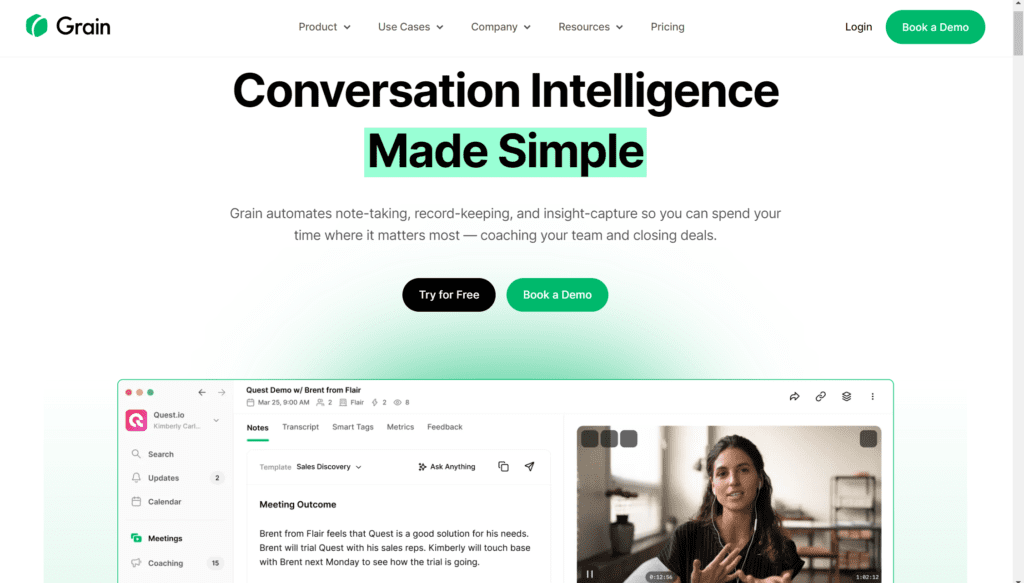
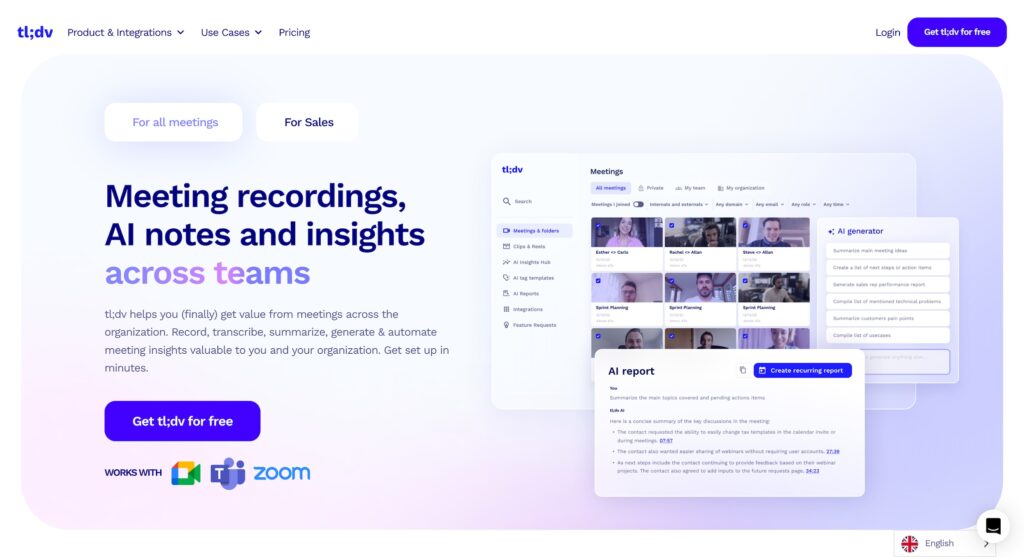
tl;dv vs Grain: 12 Factors to Consider While Choosing the Best AI Notetaker
How do we rank?
- We give 2 points to a platform once it is the clear winner or when the capability is equally met by the other.
- We give 1 point when the capability is present, but it’s not a winner.
- We give 0 points when the capability is not present.
Transcription capabilities
| tl;dv (20) | Grain (21) | |
|---|---|---|
| Transcriptions included | 🟢 Unlimited (Free) | 🟠 Unlimited (Starter Plan+) |
| Real-time transcriptions | 🔴 | 🟢 (Zoom only) |
| Languages supported | 🟢 40+ | 🟠 20+ |
| Dialects supported | 🟢 | 🔴 |
| Filler word removal | 🔴 soon | 🟢 |
| Speaker recognition | 🟢 | 🟢 |
| Speaker names | 🟢 | 🟢 |
| Transcribe video/audio uploads | 🟢 (3 free, unlimited Pro) | 🟠 (0 free, unlimited Business) |
| Export transcripts | 🟢 | 🟢 |
| Clips from transcript | 🟢 | 🟢 |
| Custom vocabulary | 🔴 soon | 🟢 |
| Full-Transcript search | 🟢 | 🟢 |
| Edit transcription | 🟢 | 🟢 |

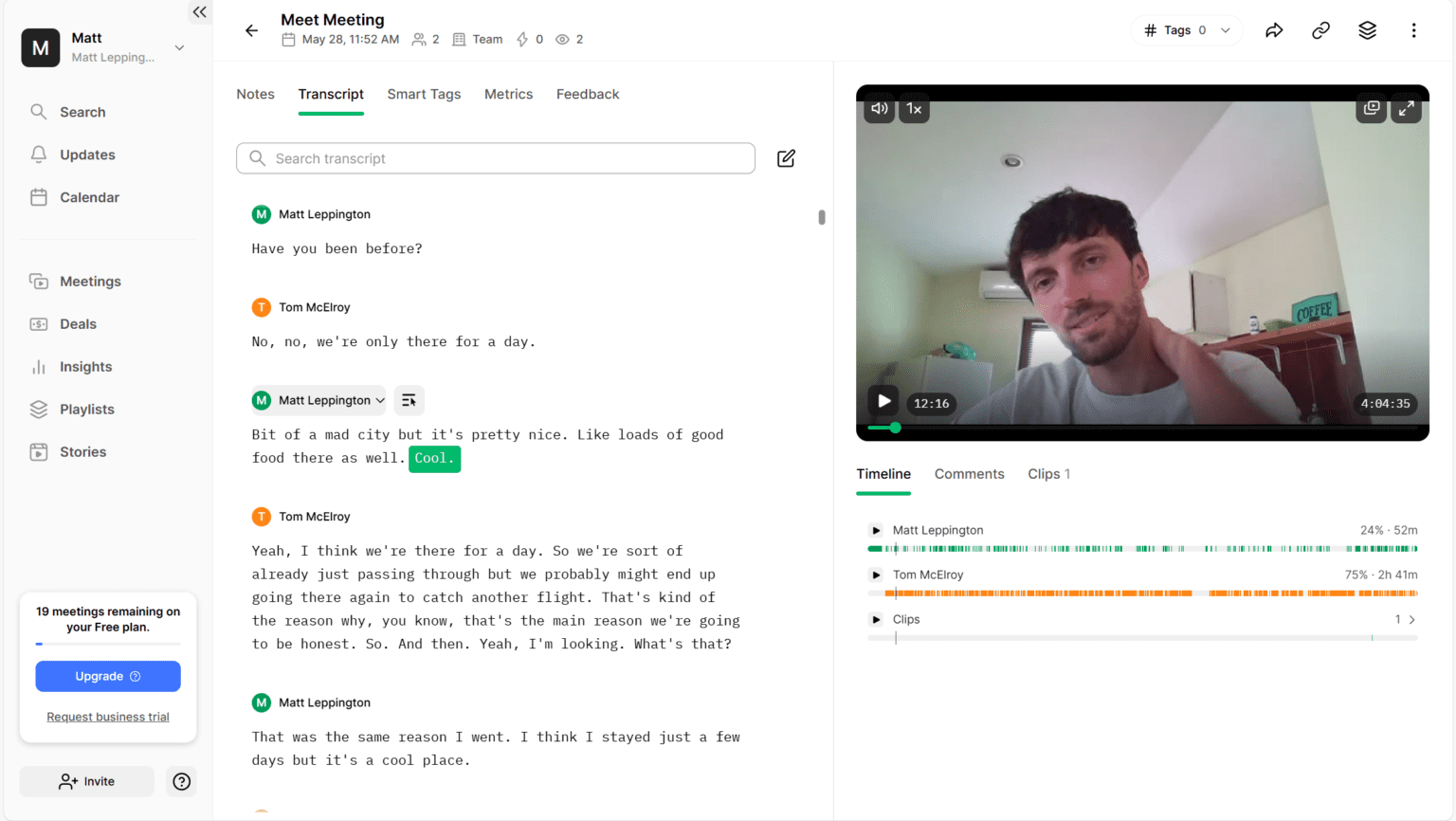
Transcriptions Included
The first point of contention between tl;dv and Grain is the amount of transcriptions you actually get access to. With tl;dv, you can get started today and have unlimited free transcripts until the end of time. Grain, on the other hand, offers just 20 meetings. It does offer unlimited in its Starter plan, but by then, you’re already paying $15 per month.
Real-time Transcriptions
Grain offers real-time transcriptions for Zoom calls, enabling users to share highlights during calls. This is especially useful if you’re working in a time-sensitive environment and can’t wait until after the call ends to update your team.
Real-time transcripts aren’t available on tl;dv, highlighting a key difference for users who prioritize instant transcription access.
Languages Supported
tl;dv’s transcripts can be translated into more than 40 languages, catering to global teams that thrive in multilingual environments.
Grain offers similar functionality but falls short in the number. You can translate Grain’s transcripts in just over 20 languages. While still great, it’s tl;dv that comes out on top if you need transcription services in a wider variety of languages.
Dialects Supported
Dialect recognition is where tl;dv has the advantage. While Grain does offer custom vocab, which we’ll get to shortly, it doesn’t offer any form of dialect support, making it a weaker option for teams with heavy dialects.
tl;dv excels here, offering enhanced transcription accuracy for users of diverse dialects. In short, it ensures the nuances of regional accents are accurately captured, something not possible when using Grain.
Filler Word Removal
Grain offers filler word removal, making sure your transcript is free from “uhhms” and “errrs”. It still includes filler words like “like” and other real-word fillers. tl;dv, however, doesn’t yet offer any filler word removal at all.
It’s worth noting that tl;dv does have filler word removal in its roadmap, and it’ll only be a short time before you can produce cleaner, more concise transcripts by eliminating unnecessary words and phrases.
Transcribe Video/Audio Uploads
Both platforms allow transcribing from uploaded audio/video files. However, Grain doesn’t offer this feature in its free plan at all, and only provides unlimited file uploads in its Business offering.
tl;dv gives you 3 free uploads so you can play around with this feature before committing. It also provides unlimited uploads in its Pro plan, sooner than Grain.
Custom Vocabulary
Grain offers custom vocabulary, allowing users to add their own words to the AI’s dictionary to ensure they show up in the transcript in the future. This is perfect for teams that use a lot of jargon in their calls. It’s a standout feature that many of its competitors haven’t yet implemented.
tl;dv is one of them. While it hasn’t added this feature yet, it’s another one that’s in the works. tl;dv aims to enhance the accuracy and relevance of transcriptions for specialized fields or terminologies in the near future.
In the meantime, if this feature is essential then Grain is the tool to turn to.
Recording Capabilities
| tl;dv (18) | Grain (14) | |
|---|---|---|
| Video platforms | 🟢 Zoom, MS Teams, Google Meet | 🟢 Zoom, MS Teams, Google Meet |
| Storage | 🟢 Unlimited | 🟢 Unlimited |
| Records video | 🟢 | 🟢 |
| Concurrent meetings | 🟢 Unlimited | 🔴 |
| Download recordings | 🟢 | 🟢 |
| Capture slides | 🟢 | 🔴 |
| Viewing analytics | 🟢 | 🔴 |
| Integrated Calendar | 🟢 | 🟢 |
| Recording Editing | 🔴 | 🟢 |
| Reels | 🟢 | 🟢 |
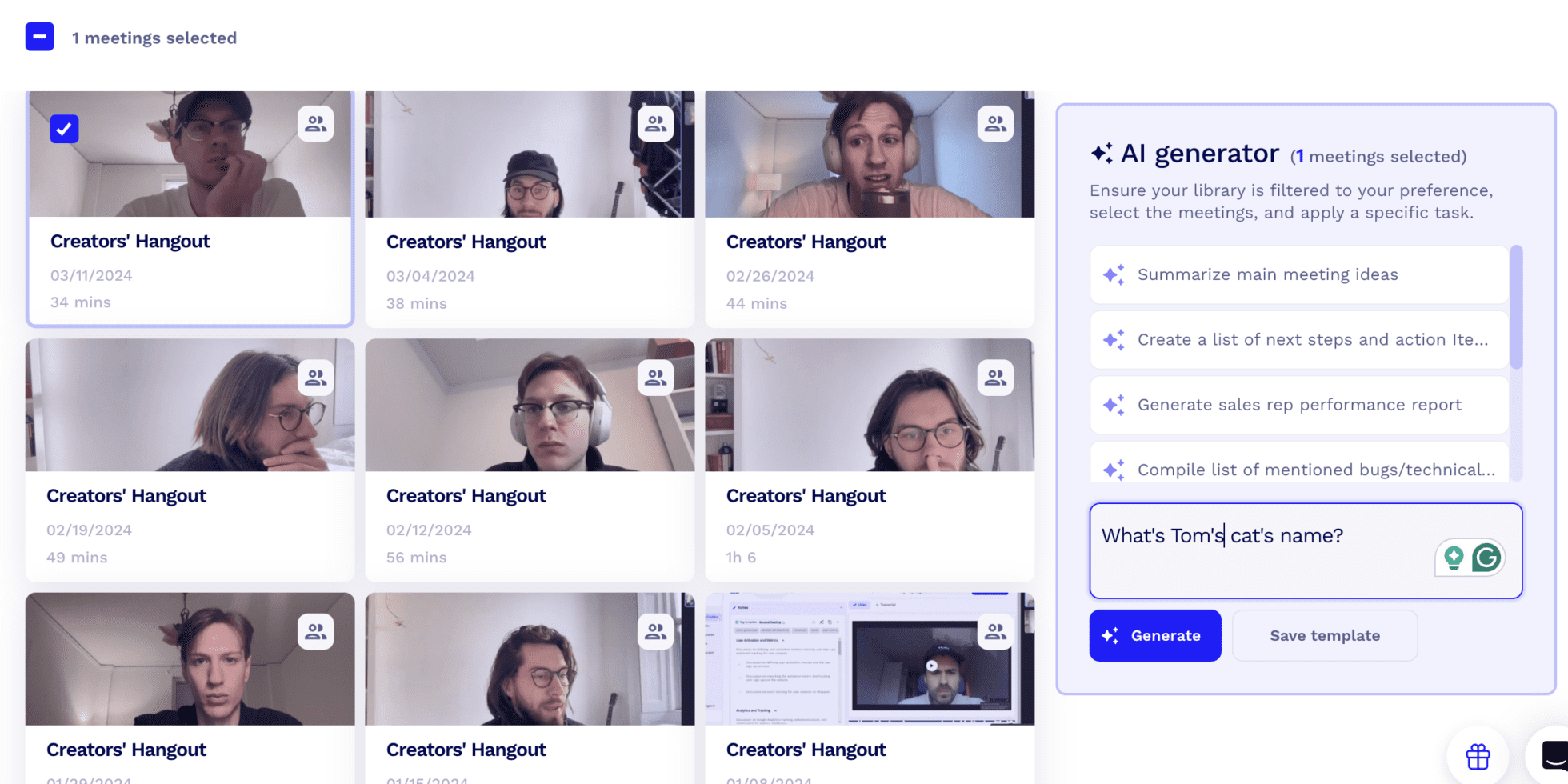
Records Video
Both tl;dv and Grain allow users to record video in their free plans. This is an important feature that enables users to rewatch their meetings as well as just reading the transcript. It empowers users to identify body language, particularly important during sales calls or user research.
As mentioned earlier, tl;dv offers unlimited free recordings whereas Grain limits their free users to 20 meetings.
Concurrent Meetings
tl;dv stands ahead of Grain here by enabling users to record multiple meetings at the same time. If you’re double (or triple+) booked, you can have tl;dv record all those meetings for you simultaneously. If you’ve got a busy schedule, tl;dv is essential to make sure you never miss a meeting.
Grain only joins one meeting at a time, severely limiting its ability to help busy teams with multiple concurrent meetings.
Capture Slides
tl;dv enables users to capture slides during a meeting, making sure that visual aids and presentations are included in the recording. This is great for meetings where the main speaker is sharing their screen as it provides valuable context and a more comprehensive meeting capture overall. It’s great for educational and collaborative purposes too, as each participant has access to the main component of the discussion afterwards.
Grain doesn’t have this capability. Users recording with Grain may miss out on critical visual elements during the meeting.
Viewing Analytics
tl;dv offers viewing analytics to its users so they can gather insights on how their team engages with meeting recordings. This feature is designed to help teams understand the effectiveness of their meetings and how content is consumed, opening up the possibility for data-driven decisions to enhance subsequent meetings.
Grain prevents users from being able to analyze meeting engagement by not offering any viewing analytics.
Recording Editing
Grain places itself ahead of tl;dv by offering recording editing capabilities that empower users to refine and edit their meeting recordings post-capture. This feature is especially beneficial for creating polished, shareable content or trimming down on unnecessary segments before distribution.
tl;dv does not currently offer recording editing, focusing instead on providing a comprehensive suite of other recording and transcription features. It does, however, enable the creation of clips and highlights.
Conversation Intelligence capabilities
| tl;dv (14) | Grain (11) | |
|---|---|---|
| Single Meeting AI Insights | 🟢 | 🟢 |
| Multi Meeting AI Insights | 🟢 | 🔴 |
| Keyword tracking | 🟢 | 🟠 in Business Plan+ |
| Sentiment Analysis | 🔴 No, as per EU AI Act | 🔴 |
| Key Topic detection | 🟢 | 🟢 |
| Speech Analytics | 🟢 | 🟢 |
| Action item detection | 🟢 | 🟢 |
| Question detection | 🟢 | 🟢 |

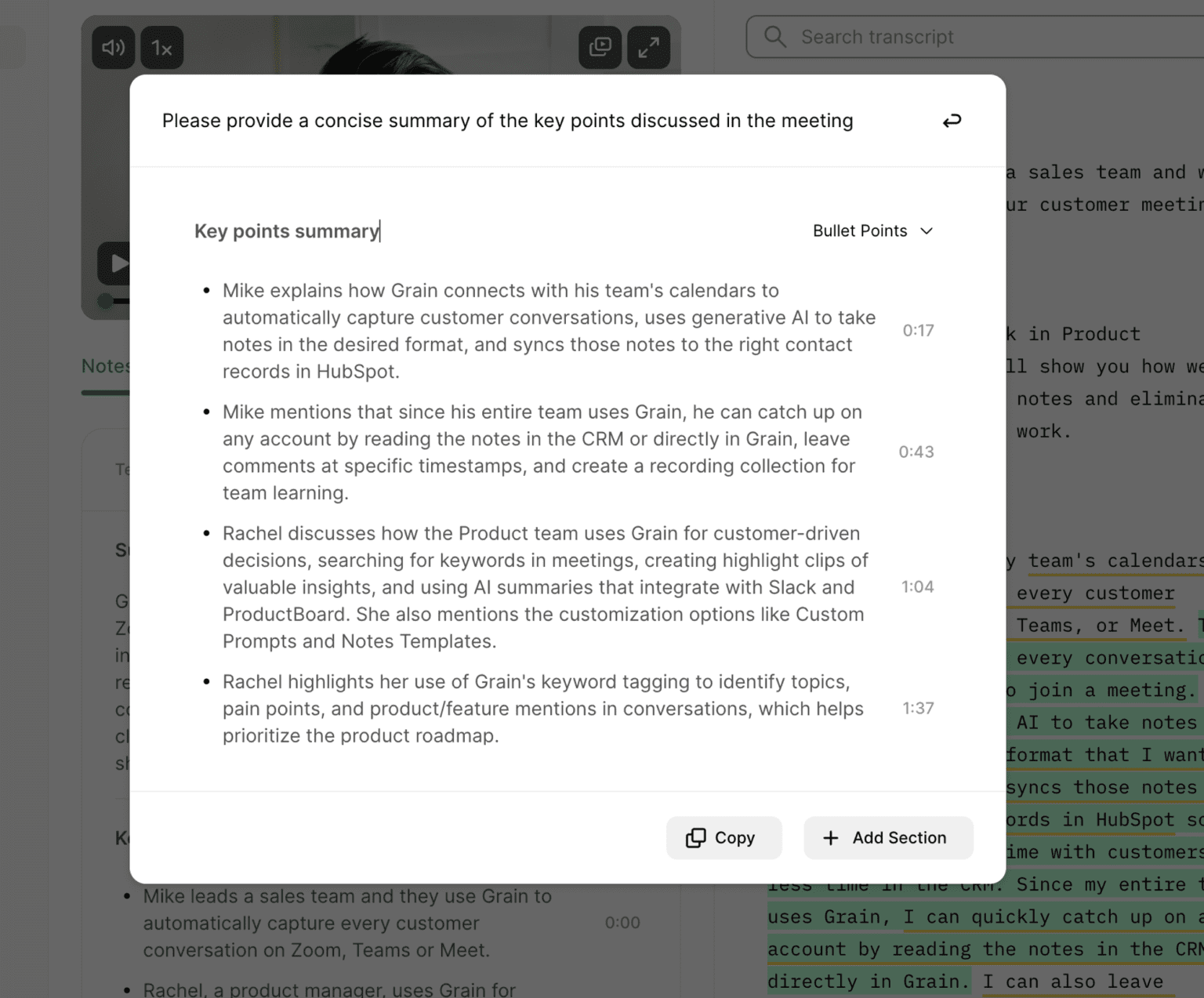
Multi-Meeting AI Insights
tl;dv stands out from the crowd of other AI notetakers, including Grain, by facilitating multi-meeting AI insights. You can schedule recurring reports based on a number of filters that will analyze multiple meetings at once and feed you back insights across all of them.
This is ideal for sales teams running multiple sales calls per day. Instead of sitting through each one, or getting AI summaries from each one, tl;dv enables you to receive an AI report of the whole day’s (or week’s or month’s) batch of sales calls. This way, you can quickly identify patterns, trends, positive things to keep up, and common pitfalls to avoid.
Grain doesn’t offer this feature, failing to take teams to the next level with its AI insights and automation.
Keyword Tracking
tl;dv offers keyword tracking, empowering users to keep tabs on specific terms across their meetings. This helps teams keep track of crucial topics or follow-up on important items.
Grain offers keyword tracking too but limits this feature to its Business plan. This may not be accessible to individual users or smaller teams, potentially limiting their ability to track and analyze specific discussion points effectively.
Speech Analytics
tl;dv’s Speaker Insights feature helps teams understand the effectiveness of their meetings. For sales teams, this feature enables you to track your talk time to listen ratio as well as other metrics like questions per hour, words per minute, and even filler words per minute. It enables users to use hard data to highlight what worked well and what needs to be improved.
Grain also offers speech analytics in its Business plan, letting users evaluate how their team interacts across different calls.
Automation & Integration capabilities
| tl;dv (10) | Grain (4) | |
|---|---|---|
| CRM Integrations | 🟢 in Pro plan | 🟠 in Business plan |
| Email Integrations | 🟢 | 🔴 |
| Zapier Integrations | 🟢 in Pro plan | 🟢 in Starter plan |
| Post-Meeting summary email | 🟢 automatic | 🟠 1-click |
| Schedule Reports | 🟢 | 🔴 |
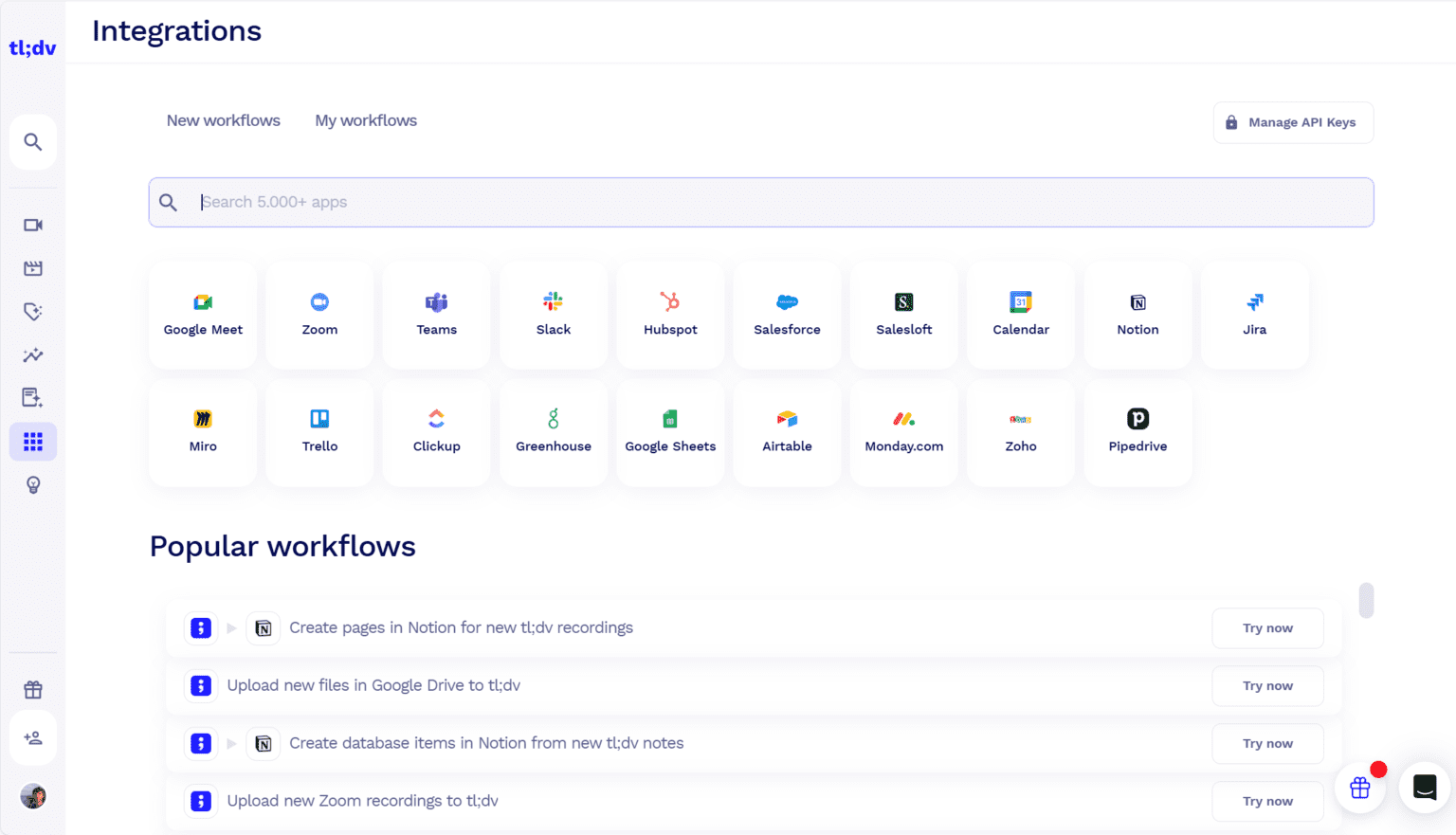
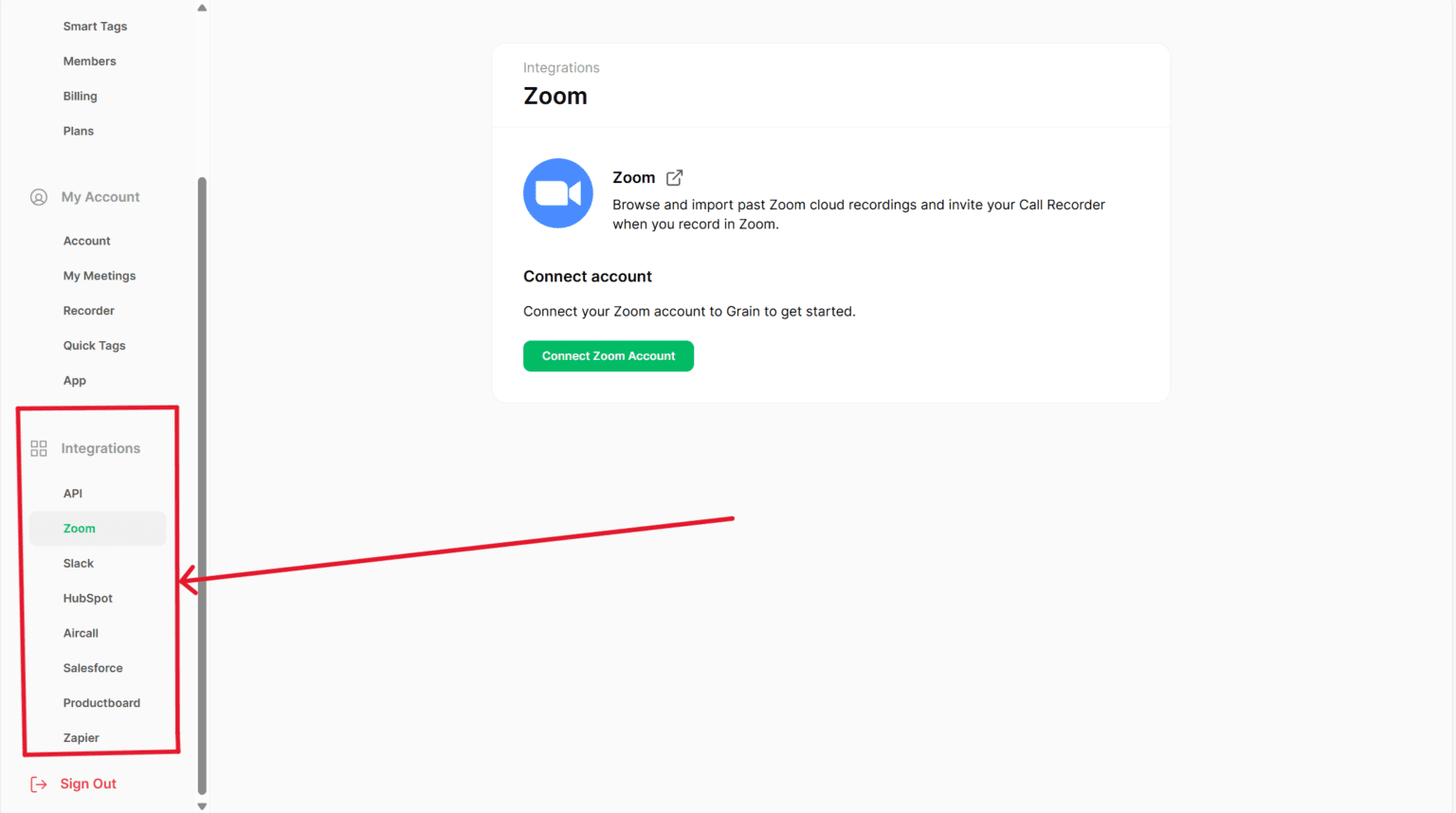
CRM Integrations
All of tl;dv’s native integrations, including CRMs like Salesforce, Hubspot and Pipedrive, are available in the Pro plan. This allows teams of all sizes to streamline their workflow and automate tedious processes.
Grain, on the other hand, limits this feature to their Business plan, and provides limited CRM options compared to tl;dv. It does offer an integration with Zapier which can then be used to connect to a different CRM of your choice. However, this is an extra step and requires a third party. Plus tl;dv also includes a Zapier integration if your CRM of choice isn’t included in their 5,000+ native integrations.
Email Integrations
tl;dv offers email integration for free. This means that your meeting recordings and transcripts will automatically be sent to your (and all participant’s) email after the call ends.
Grain doesn’t integrate with any email provider. If you want to send the recording or transcript via email, it can still be done in one click, but it’s not automatic.
Zapier Integrations
Both tl;dv and Grain offer integration with Zapier. Zapier is a popular integration tool that connects different SaaS apps with each other, making it super valuable if no native integration is available.
Post-Meeting Summary Email
All participants of a tl;dv-recorded call will get a post-meeting summary email automatically sent to their inbox as soon as the call ends. This will cover the main topics and include timestamps for the user to rewatch specific moments quickly and easily.
Grain doesn’t offer an automatic post-meeting summary email, however, you can send the recording and transcript in a follow-up email in a few simple clicks.
Schedule Reports
tl;dv empowers users to schedule recurring reports that cover multiple meetings in one in-depth report crammed full of analysis, insights, and more. You can filter which meetings you want to be included by keyword, topic, participants, or more.
Grain does not allow users to schedule reports. They can receive an AI summary for an individual meeting, but not regular reports across multiple meetings. This potentially hinders the platform from making any meaningful insights across a broader spectrum of calls.
Note-taking capabilities
| tl;dv (10) | Grain (6) | |
|---|---|---|
| AI Notes | 🟢 | 🟢 |
| Manual notes during calls | 🟢 needs app | 🟠 needs app (Zoom only) |
| Tag people in notes | 🟢 | 🔴 |
| Assign tasks | 🔴 | 🔴 |
| AI Tags / Bookmarks | 🟢 (Free) | 🟠 (Business+) |
| Comments | 🟢 | 🟢 |
AI Notes
Both Grain and tl;dv offer up AI notes, letting users focus on the conversation first and foremost. This is great for maintaining concentration in important calls as you can be sure that the AI will pick up on all the important things you need to remember.
Manual Notes During Calls
When you want to make a note for something small that the AI wouldn’t ordinarily pick up, you can do that with both tl;dv and Grain so long as you have their respective apps. Grain’s app, however, is only compatible with Zoom calls, which can be a hindrance for teams using other video conferencing platforms.
Tag People in Notes
tl;dv lets users tag colleagues or relevant people in the notes on the transcript. Tagged people get an email sent straight to their inbox with the timestamp to the specific note. This allows them to jump straight to the relevant part for them.
Grain doesn’t allow users to tag people in notes, making it more tedious to show a colleague specific insights from the recording.
AI Tags
Both tools support AI tags, enabling users to quickly and easily bookmark and revisit important parts of a meeting. This feature is available across all plans on tl;dv, including the Free plan.
Grain offers Smart Tags (trackers) but only for Business and Enterprise plans. This feature increases the efficiency of reviewing meeting recordings and notes, making it much easier to search through past meetings. However, limiting this option to the Business plan could restrict the average user from being able to seamlessly review their meetings.
Security capabilities
| tl;dv (19) | Grain (8) | |
|---|---|---|
| Data retention | 🟠 6 months on FREE plan Unlimited on all paid plans | 🔴 not disclosed |
| SOC2 Compliant | 🔴 (certification underway) | 🟢 |
| SAML-based SSO | 🟢 Only on Enterprise | 🟢 Only on Enterprise |
| GDPR Compliant | 🟢 | 🔴 not disclosed |
| EU AI Act Compliant | 🟢 | 🔴 not disclosed |
| Uses your data to train AI | 🟢 (No, your data is kept private) | 🟢 (No, your data is kept private) |
| Private storage | 🟢 Only on Enterprise | 🔴 not disclosed |
| Anonymised sensitive data sent to LLMs | 🟢 | 🟢 |
| Meeting data chunking and randomizing | 🟢 | 🔴 not disclosed |
| BAA with LLM providers | 🟢 | 🔴 not disclosed |
| 0-day data retention policy with vendors | 🟢 | 🔴 not disclosed |
Data Retention
tl;dv offers a clear data retention policy, guaranteeing 6 months of data retention for users on its Free plan and unlimited data retention for all paid plans.
Transparency in data retention policies is crucial for organizations managing sensitive information. In contrast, Grain has not disclosed its meeting data retention policies, which could potentially raise concerns for users with rigid data management requirements.
SOC2 Compliant
While tl;dv is on track to become SOC2 compliant, highlighting its commitment to achieving high standards of security and data protection, Grain is already SOC2 compliant.
This certification reassures Grain’s users by offering an extra layer of trust and reliability.
GDPR Compliant
tl;dv is GDPR compliant, ensuring it follows the European Union’s strict regulations on data protection and privacy.
Grain has not disclosed whether or not it’s GDPR compliant, making it a risky move for those serious about data protection.
EU AI Act Compliant
tl;dv, an EU-based company with servers in Europe, is compliant with the EU AI Act, indicating its dedication to ethical AI practices and regulatory adherence.
Whether or not Grain is compliant with the EU AI Act remains unknown, which may be an important factor for users operating within the EU or concerned with EU regulations.
Private Storage
Private storage is a critical feature for businesses that prioritize data sovereignty and security. It’s available on tl;dv for all Enterprise users.
Grain hasn’t advertised any private storage feature, likely indicating that it doesn’t have one. This can affect the decision-making process for larger organizations with specific storage needs.
0-Day Data Retention Policy
tl;dv deletes or anonymizes data immediately after its purpose was served. This emphasizes tl;dv’s stance on minimizing data exposure. It also explains these guidelines in a clear manner that’s easy for users to find and understand.
Grain has no such policy disclosed, potentially creating problems for users with strict data governance policies.
Coaching capabilities
| tl;dv (8) | Grain (0) | |
|---|---|---|
| Playbooks Scorecards | 🟢 | 🔴 |
| Custom Playbooks | 🟢 | 🔴 |
| Template Playbooks | 🟢 | 🔴 |
| Objection Handling | 🟢 | 🔴 |
If you want your meeting recorder to help you improve your sales calls, tl;dv is your only real option. It provides an ever-expanding suite of coaching capabilities, from playbooks to objection handling, that Grain simply doesn’t cater for. Here are tl;dv’s main four coaching areas:
- Playbooks Scorecards: Scorecards help track and evaluate individual or team performance during meetings, offering insights for personal improvement. Users can create a performance scorecard for any selected group of meetings, allowing them to monitor and analyze performance across multiple sessions.
- Custom Playbooks: Users have the freedom to set their own guidelines and best practices for conducting effective meetings. By applying these custom playbooks, users can guide and assess the execution of any meeting (or series of meetings), ensuring consistency and adherence to proven strategies.
- Template Playbooks: tl;dv has an array of pre-made templates that teams can adapt to their coaching strategies.
- Product (Research Interview, User testing).
- Project (Sprint planning, Stand-up meeting, Brainstorming, Kick-off)
- HR (Job Interview, Exit Interview, Entry Interview).
- Customer Success (Retrospective meeting, Business Review, Customer onboarding meetings, Customer check-in meetings, Feedback call).
- Sales (Demo call, MEDDIC, SPICED, BANT, Discovery call, GPCT, CHAMP, ANUM, BEBEDC, SPIN).
- Management (Performance Improvement Plan, 1:1 meeting, Offboarding 1:1, Performance Review).
Objection Handling: This feature provides sales and CS teams with detailed performance evaluations specifically focused on how they respond to objections from prospects. It uses meeting data and insights to create scorecards that highlight strengths and weaknesses in objection-handling skills, assisting teams with refining their techniques – all within the platform.
Admin Capabilities
| tl;dv (8) | Grain (4) | |
|---|---|---|
| Apply auto-record of all meetings in the team members’ calendar | 🟢 | 🟠 (your meetings only) |
| Apply auto-share of meetings recorded by team members | 🟢 | 🟠 (your meetings only) |
| Prevent Deletion | 🟢 | 🔴 |
| Admin rights over all recordings | 🟢 | 🟢 |

Auto-Record All Meetings in the Team Members’ Calendar
tl;dv allows admins to arrange for all meetings scheduled in team members’ calendars to automatically be recorded. This ensures a detailed overview of discussions and decisions which can later be turned into reports. This feature is essential for accountability and knowledge sharing.
In contrast, Grain doesn’t grant admins this power, leaving it down to the users to do manually. This can be problematic for managers who want to guarantee that all meetings will be recorded. Grain does allow for users to auto-record all meetings, but only from their own calendar.
Auto-Share Meetings in the Team Members’ Calendar
Administrators using tl;dv can automatically share meetings recorded by team members, making the meeting distribution process seamless and streamlined. This feature improves collaboration over the entire organization. Stakeholders gain instant access to recordings through automatically shared meetings too, saving them time and energy.
Grain doesn’t offer this feature, preventing teams from maximizing their productivity and efficiency. Grain does allow for users to auto-share meetings, but only from their own calendar.
Prevent Deletion
This unassuming feature is actually a pretty big deal. The ability for admins to prevent deletion provides a huge reassurance to sales teams as there are reps who may delete incriminating sales call recordings before admins have had a chance to review them. By preventing deletion, tl;dv enables admins to oversee all sales calls throughout the entire organization, layering in additional accountability and trust.
Grain lacks this feature, giving responsibility to the person who recorded each call to have the final say on what gets deleted and what doesn’t, leaving admins in the dark.
Admin Rights Over All Recordings
tl;dv enables admins to have rights over all recordings, making them the overseer of all meetings in your organization. This makes management easier.
Grain also lets their admins have rights over all recordings via their collaborative workspace. This is great for big teams as you can have an admin oversee all meetings from a single workspace.
Organizational Capabilities
| tl;dv (12) | Grain (8) | |
|---|---|---|
| Team Workspaces | 🟢 | 🟢 |
| Meetings Library | 🟢 | 🟢 |
| Smart Filters | 🟢 | 🔴 |
| Global Search | 🟢 | 🔴 |
| Search within meetings | 🟢 | 🟢 |
| Folders | 🟢 | 🟢 |
Team Workspaces
Grain has a collaborative workspace that you can work from as a team. This is available from the free plan upwards, but admin access doesn’t kick in until the Starter plan.
tl;dv also offers team workspaces across all its plans, including the Free Forever plan. This feature empowers teams to seamlessly collaborate and share content within their own dedicated space.
Smart Filters
tl;dv helps the user sort through meeting criteria efficiently with its Smart Filters feature. With this functionality, meeting insights are super easy to search through, ensuring your team never misses an important detail.
Grain doesn’t provide Smart Filters, lowering its organizational capabilities and making it more difficult for users to sort and retrieve information.
Global Search
tl;dv enables users to search through their entire meeting library to find exact moments from calls. You can search via keyword, or even find something from your notes or comments.
Grain doesn’t allow users to search through all their meetings at once, drastically reducing their ability to find important information quickly.
Folders
tl;dv empowers users to organize their meetings in whichever way they seem fit. Folders enable teams to break different meetings into different categories. It’s worth noting that the Team Folders feature isn’t unlocked until the Pro plan.
Grain’s Playlist feature does the same thing. Unlocked in their free plan, Grain allows its users to organize their meetings into folders from the get-go, making them great for teams that love streamlined organization.
Support Capabilities
| tl;dv (4) | Grain (2) | |
|---|---|---|
| Support in Free Plan | 🟢 chat & email | 🟠 email in Free plan |
| Priority Support | 🟢 in Pro plan | 🟠 Only in Enterprise plan |
Support in Free Plan
On the Free plan, tl;dv offers speedy and efficient support through both online chat and email. Users have multiple channels to find the help they need to resolve their issues, meaning they always have a way to get in touch with somebody when they need it. This method doesn’t discriminate against people with lower subscription levels.
Grain offers free support too, but only in email form. Because of the lack of online chat, Grain’s free users can expect longer response times in comparison to tl;dv.
Priority Support
tl;dv’s priority support starts with the Pro plan, offering a faster and more comprehensive customer service experience in the first paid option.
Grain’s priority support doesn’t kick in unless you’re on the Enterprise plan. All other subscribers must wait for support via email, which can be quite frustrating, especially over weekends or busy periods.
Revenue Intelligence Capabilities
| tl;dv (0) | Grain (0) | |
|---|---|---|
| Forecasting | 🔴 | 🔴 |
| Deal execution | 🔴 | 🔴 |
Neither tl;dv nor Grain offer features related to Revenue Intelligence such as Forecasting and Deal Execution. Users searching for specialized sales tools would have to look elsewhere, however, these tools aren’t cheap. Revenue intelligence tools are often $1,000+ per user and can rise steeply depending on the extra features your team requires.
If you’re after a revenue intelligence tool to improve your team’s sales skills, then take a look at tl;dv’s innovative coaching solution which uses your sales call data to suggest strategic improvements.
Who is it for?
| tl;dv (6) | Grain (3) | |
|---|---|---|
| G2 Rating | 🟢 4.7 | 🔴 4.6 |
| Ease of set up | 🟢 Generous free plan + Clean UI | 🟠 Easy, but limited free plan. |
| Localized platform | 🟢 (7 languages) | 🔴 |
| Best suited for whom | 🟢 SMB Sales | 🟢 SMB Sales |
tl;dv and Grain both cater to SMB Sales teams, making them perfect companions for sales reps in English speaking countries and beyond. tl;dv’s coaching features give it an edge for teams within their shared niche.
If your team requires a localized platform in multiple languages, Grain is not the platform to use. tl;dv, however, has a localized platform in 7 different languages, making it excellent for international sales teams or global marketing teams that require multiple languages.
Both tools are easy enough to get started with. It takes mere moments to create an account and be recording your first meeting. The difference is that tl;dv lets you use its most basic features (recording and transcribing) infinitely without paying. Grain limits even these most basic of features to just 20 meetings.
Verdict: tl;dv vs Grain – which one is the best?
| tl;dv | Grain | |
|---|---|---|
| Transcription | 20 | 21 🟢 |
| Recording | 18 🟢 | 14 |
| Conversational Intelligence | 14 🟢 | 11 |
| Automation & Integrations | 10 🟢 | 4 |
| Note-taking | 10 🟢 | 6 |
| Security | 19 🟢 | 8 |
| Coaching | 8 🟢 | 0 |
| Admin | 8 🟢 | 4 |
| Organizational | 12 🟢 | 8 |
| Support | 4 🟢 | 2 |
| Revenue Intelligence | 0 | 0 |
| Other | 6 🟢 | 3 |
| Total | 128 🟢 | 81 |
Grain puts up a good fight and scores a respectable 81 points overall, but it’s tl;dv that comes out on top, storming ahead with 128 points.
However, the decision between tl;dv and Grain isn’t that simple. It comes down to your business’s specific needs. Grain offers some great features that tl;dv lacks: real-time transcriptions, filler word removal, recording editing, and custom vocabulary. Grain’s a fantastic tool if you’re mostly after a high quality transcript.
However, if a smoother overall UI, almost 1,000x more native integrations, concurrent meeting support (and multi-meeting intelligence), keyword tracking, smart filters, and powerful coaching resources are more important to you and your team, then tl;dv is the ultimate choice.
tl;dv’s coaching, playbooks, and objection handling features are what make it stand head and shoulders above the crowd for sales teams.
Finally, tl;dv is better for asynchronous multi-national teams with its multilingual localized platform and higher number of transcript translation languages.
Ultimately, the choice is yours and yours alone. Whichever tool will help boost your business the most is the one you should be using. Whichever you pick, you’re on the road to utilizing AI meeting intelligence to streamline, organize, and automate your workflows.

